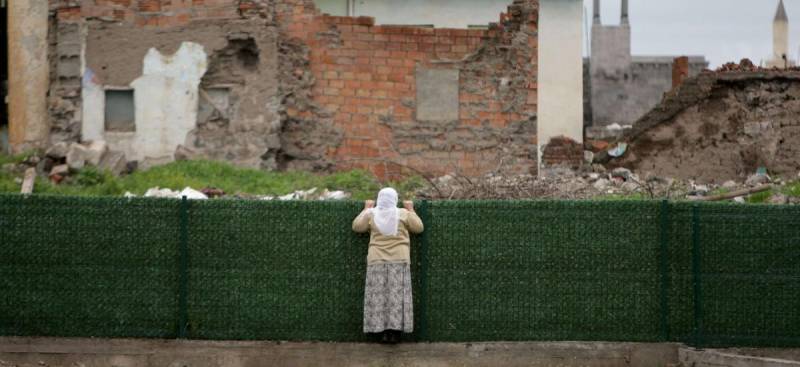The neighbourhood of Sur in Turkey’s predominantly Kurdish southeastern province of Diyarbakır is our home of 7,000 years.
The ancient neighbourhood, which once flourished as a popular tourism destination in the heart of the Kurdish capital of Amed, and is a UNESCO World Heritage Site, has been through hell over the last six years.
Destroyed in the conflict between the Kurdistan Workers’ Party (PKK) and the Turkish military, faced with years of curfews, forced evictions, demolitions and most recently what is being called an urban transformation project, Sur today is a source of grief for myself and other local residents.
An advertisement featured in Turkish media last week on “touristic villas” in Sur, touted luxury homes in the six neighbourhoods of Sur, ranging between 600,000 and one million liras ($83,000-$139,700).
“Where history and luxury intertwine,’’ the advertisement said.
It might be useful to take a trip into recent history for those who don’t know the story of the land these premium luxury villas have been built on.
It all began back in August of 2015, when clashes broke out in the region following the collapse of peace talks between the PKK and the Turkish government, ending a two-year ceasefire in a conflict that has killed more than 40,000 people.
The peace talks came to an end when a group allegedly linked to the PKK carried out an attack, killing two policemen in July 2015. A string of injustices against Turkey’s Kurdish community, which makes up roughly 15 percent of the country’s population, followed thereafter.
At the heart of the clashes was the historic neighbourhood of Sur.
The following month, the first curfew was declared in Sur. Initially these curfews were only a few days long. Residents would not leave their homes during these times as clashes intensified and ditches and barricades grew larger. Curfews lasted until Nov. 2015, ranging between three to five days at a time.
There were lives lost during every interval of the restrictions, but Sur did not undergo an entire destruction, nor did the people of Sur abandon the neighbourhood. After the murder of prominent human rights lawyer Tahir Elçi at the foot of the historic minarets on Nov. 28, 2015, a fifth curfew was put into effect on Dec. 2. That is when military operations began and the entire town was buried under a sphere of smoke and sound. The curfew ended on Dec. 11 for a period of 17 hours. That is when thousands of Sur residents abandoned the neighbourhood with whatever they could take with them.
The 100-day military operations ended on March 9, 2016 at 4 p.m. local time, leaving behind around 100 dead (the precise number of victims remains unknown to this day) and extensive damage to the city.
When we look at the report prepared by the Sur municipality on the destruction, which features satellite images from March 2016, we see that the neighbourhood was still in a restorable state. But that was not the route that was taken. Instead, bulldozers and trucks entered the neighbourhood and began destroying the thousands of years of history it was home to. The homes, lives, memories and even dead bodies of the residents of the six neighbourhoods were dumped into the Dicle Valley as rubbish.
Then with a decision passed by the cabinet in March 2016, Sur was expropriated. And small amounts of money were given to residents in neighbourhoods with restrictions in exchange for their homes. Those who refused went to court and, as expected, nothing became of their cases.
The buildings in this neighbourhood were destroyed, a total of 3569 of them to be exact, turning the area in an abandoned field, atop which freakish villas began to be constructed. Meanwhile, the Sur Protection Plan to preserve the area was violated, with large boulevards laid out in areas flagged as protected.
Throughout this whole process a curfew continued in a neighbourhood that is effectively uninhabited. The restrictions in the present day ghost town continue to this very day.
But the demolition did not end there. In the summer of 2017, the historic Alipaşa neighbourhood, which was not caught up in the clashes, was also destroyed in the name of urban transformation. Within a few months, the neighbourhood of thousands of years vanished. More strange villas were built atop the land there, too.
By 2018, there was construction everywhere in Sur. The “renewal project’’ first began on main streets before expanding into what is known as the Çarşîya Şewîti. All shops were given a wood and basalt facade, becoming replicas of each other. And people continued to live under the restrictions.
There has been a slow revival in Sur over the past few years as we have managed to live through the demolition and new neighbourhood erected around us. We sat in cafes, looking at the section of the city that has been closed off under construction, pretending as though we still lived freely in the same place we called home.
But over time, restrictions and destruction have become a part of our lives. Youth continue to spray paint graffiti on the walls of Sur and new cafes continue to open. Sur has become a place where restrictive measures and life intertwine, where abject poverty is face to face with posh cafes. One side of a street in Sur has a Starbucks and the other is under curfew.
But no matter how hard to try to turn a blind eye to it, the truth is that we have lost our home of 7,000 years. We have lost Diyarbakır, Amed and the heart of Dikranagerd.
And I would like to tell the people looking to purchase these luxury homes resting on our land that they will never benefit from living here, because the residences came at the price of blood, sweat and tears and suffering of its residents.
